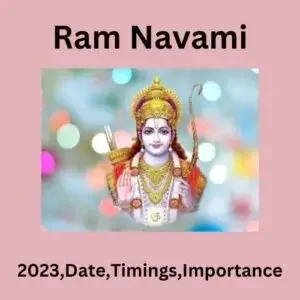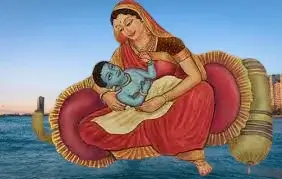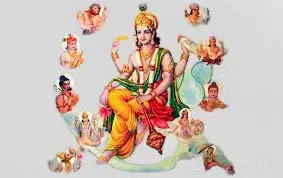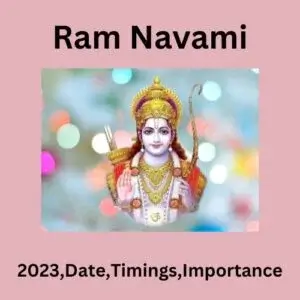Ram Navami is a Hindu festival that celebrates the birthday of Rama ( Maryada Purushottam ), the seventh avatar/incarnation of lord/deity Vishnu. The festival celebrates the descent of Vishnu as the Rama avatar, through his birth to King Dasharatha and Queen Kausalya in Ayodhya, Kosala.
Ram Navami
Ram Navami is an important Annual Hindu festival, celebrated every year on the ninth day of Chaitra month (the first month in the Hindu lunar calendar) — it falls on March 30 this year in 2023. It is also celebrated as the conclusion of Chaitra Navratri. Devotees of Maa Durga and Lord Ram organise havan at their homes, end the nine-day-long Navratri fast, visit temples, wear new clothes, and more. This typically occurs in the months of March or April by the Gregorian calendar. Rama Navami is an optional holiday for government employees in India.
Lord Rama is believed to be an ideal human being and a symbol of truth, righteousness, virtue, bravery, courage, and devotion to his duty. The Ram Navami festival – celebrating Lord Ram’s birth, is recorded in Ramayana, considered one of the two great Sanskrit epics of the Hindu religion. The story of Ram Navami is also called the Vratha Katha.

Timings 2023
The Ram Navami madhyahna muhurat will begin at 11:11 AM and end at 01:40 PM.
Ram Navami Date: March 30 (Thursday)
Ram Navami Madhyahna Muhurat: 11:11 AM to 01:40 PM
Ram Navami 2023: Subh Muharat
Ram Navami Madhyahna Moment – 12:26 PM
Navami Tithi Begins – 09:07 PM on March 29
Navami Tithi Ends – 11:30 PM on March 30
Significance & Celebrations
The significance of the festival is that it indicates the victory of good over evil and establishment of dharma to beat adharma. The Rama Navami festival celebration starts with jalam (water) offering in the early morning to Surya (the sun god) to propitatiate him. This is due to the belief that the descendants of Surya were the ancestors of Rama.
Ram Navami is celebrated with great joy and enthusiasm. Placing the idol of Lord Rama along with Sita, Laxman, and Hanuman in public pandals and offering prayers, chanting hymns, and presenting popular plays like Ramlila with magnificent dedication are the major attractions of this festival.
Many devotees stay awake during the night to perform bhajan and kirtan. Also, people commemorate this day by washing and dressing statues of Lord Ram and placing them in a shrine. During these days, Ayodhya organises ceremonies to worship Lord Rama and Maa Sita.
This day is enjoyed on the Shukla Paksha in the month of Chaitra that is on the ninth day called Navami. It is also known by the name of Chaitra Suklapaksha Masa Navami.
This festival is celebrated for nine days and is called Navaratri or Sri Rama Navaratra. Many Bhajan, kirtan along with aartis are done during these days. Social gatherings are also done on this occasion. It is believed that God Rama was born at noon. Temples and houses are decorated for this occasion and various prayers and mantras are chanted. Havans and vedic mantras are chanted to please God. Groups are made and the name of Rama is chanted all over the night.
Allthough the festival is celebrated all around India, there are few places where it is celebrated with great pomp and show. These places are Ayodhya, in Uttar Pradesh, Sitamarhi also called Sita Samahit Sthal in Bihar and Bhadrachalam that is in Telangana.
In ISKCON temples, this festival is celebrated with lots of zeal. On Rama Navami, the birth celebration of Swaminarayan (Born in Chhapaiya) is also celebrated.
Lord Rama, who became king of Ayodhya, was known for His exemplary qualities. He was popular, brave, kind, just, intelligent, patient, loving, obedient and dutiful. Lord Rama is always worshiped with his consort Sita, brother Lakshmana and devotee Hanuman. The worship of Lord Rama is accompanied by the worship of the Sun god since Ram was considered to have descended from the sun, or is in the Solar dynasty. Ram Navami celebrations include reading the great epic Ramayana and staging plays of the Ram Lila, or the pastimes of the life of Lord Rama.
Ayodhya (Uttar Pradesh), Bhadrachalam (Andhra Pradesh) and Rameswaram (Tamil Nadu) are the main places where one can witness the grandest observances of the occassion. Thousands of devotees and tourists from different nations throng these places during Ram Navami to get a feel of the religious excitement.
Rama Navami is one of the Hindu festivals that is celebrated by the Indian diaspora with roots in Uttar Pradesh and other states. The descendants of Indian indentured servants who were forced to leave India due to British-engineered famines and then promised jobs in colonial South Africa before 1910 in British-owned plantations and mines, and thereafter lived under the South African apartheid regime, continued to celebrate Rama Navami by reciting the Ramayana and by singing bhajans of Tyagaraja and Bhadrachala Ramdas. The tradition continues in contemporary times in the Hindu temples of Durban every year.
In Trinidad and Tobago, Guyana, Suriname, Jamaica, other Caribbean countries, Mauritius, Malaysia, Singapore, and many other countries with Hindu descendants of colonial-era indentured workers forced to leave British India have continued to observe Rama Navami along with their other traditional festivals.
It is also celebrated by Hindus in Fiji and those Fiji Hindus who have re-migrated elsewhere.
Birth story of Lord Rama:
The country of Kosal was situated on the banks of the river Sharayu. Ayodhya was the capital founded by the king rishi Manu. During the reign of king Dasarath, Ayodhya reached a period of great prosperity. But Dasarath faced a big problem: he had no children. Therefore he decided to perform a sacrifice known as “ashvamedh”, or horse-sacrifice. Elaborate and difficult rituals had to be observed. A very holy man, rishi Rishyashring, was chosen to conduct the sacrifice with the utmost accuracy. The performance of this sacrifice was a great event in Ayodhya.

At the end Rishyashring recited a mantra and made an offering to the fire. Then the gods, gandharvas, siddhas, and rishis present arid began to pray to Brahma.
At that time Ravan, king of Lanka, was terrorizing the people, and all were longing for liberation from his menace. Ravan had acquired great power because he had obtained from god Brahma the boon that he would never die at the hands of gods, or gandharvas, or yakshas (demigods) or demons. As he was not afraid of men he did not care to include men in the list of his potential slayers. So Brahmadev declared that Ravan would die at the hands of a man. Then the gods went to Vishnu with the request, “Dasarath is a glorious king. Please, take birth in the wombs of his three queens in four different degrees of your divinity.”
When Dasarath’s sacrifice came to an end a shining figure appeared over the sacrificial kund, and offered the king a divine beverage called “payasam” to be given to his queens Kausalya, Kaikayi, and Sumitra. In due time Kausalya gave birth to Rama, Kaikayi to Bharat and Sumitra to Laxman and Shatrugna. Rama was born at noon of the bright ninth day of Chaitra. He was believed to be the embodiment of half degree of Vishnu’s divinity
To know more about Ram Navami, click here.
Dashavatara of Vishnu
According to Swami Parmeshwaranand, although the avatars of Vishnu are countless in number and include hermits, Manus, sons of Manus, and other Devas (gods), due to the curse of a Rishi called Bhrigu most are only partial (i.e. incomplete) incarnations. The Dashavatara is a list of the ten complete (i.e. full) incarnations.

| Positions | Avataras/Incarnations | Yuga |
| 1 | Matsya | Satya Yuga |
| 2 | Kurma | |
| 3 | Varaha | |
| 4 | Narasimha[ | |
| 5 | Vamana | |
| 6 | Parashurama | Treta Yuga |
| 7 | Rama | |
| 8 | Krishna | |
| 9 | Buddha | Dvapara Yuga |
| 10 | Kalki | Kali Yuga |
Follow read4knowledge for more regular updates.
